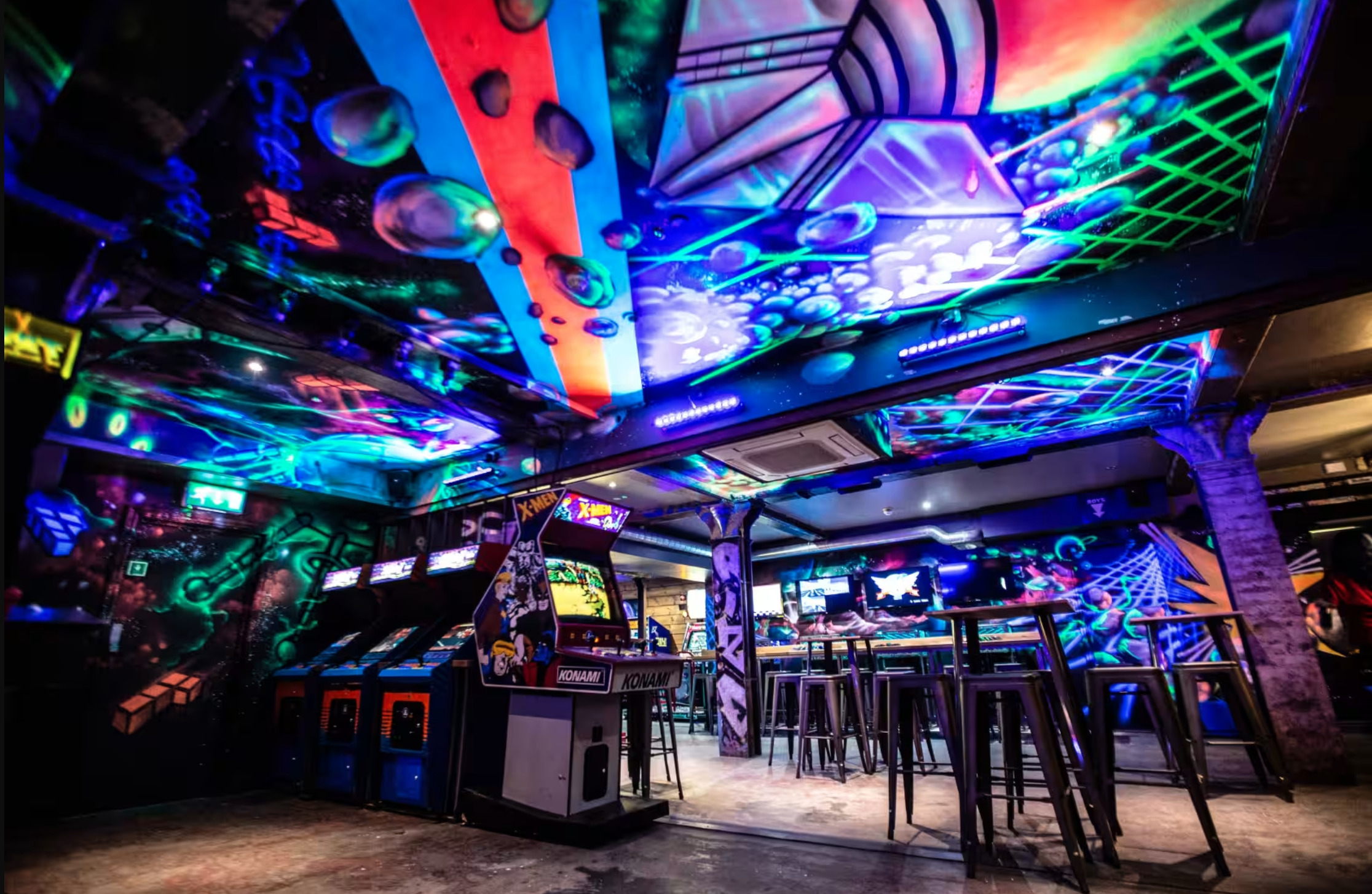How to Create a Unique and Engaging Experience
Immersive entertainment pop-ups are one of the fastest-growing trends in the leisure industry, offering a blend of storytelling, technology, and audience participation to create memorable, one-of-a-kind experiences.
From pop-up theatres and interactive art installations to virtual reality spaces and competitive socialising venues, immersive pop-ups have become an exciting way for creators to engage audiences, test concepts, and make a lasting impact in a short amount of time.
This playbook provides a step-by-step guide to creating your own immersive entertainment pop-up, whether you’re a seasoned professional or a first-time creator looking to bring your vision to life.
Step 1: Defining Your Concept
Before diving into the logistics, it’s crucial to develop a clear concept for your immersive pop-up. Your concept will drive the creative direction, audience engagement strategy, and the technology you use.
Key Questions:
- What story or experience are you creating? Whether it’s a historical narrative, futuristic adventure, or artistic installation, identify the core theme of your pop-up.
- What emotions or experiences do you want participants to have? Are you aiming for excitement, wonder, mystery, or something entirely different?
- How will participants interact with the environment? Immersive pop-ups often rely on audience participation, so consider how your visitors will engage with the space and the narrative.
Example Concepts:
- Interactive Mystery Experience: Participants explore a crime scene, solve puzzles, and uncover clues to unravel a story.
- Art-Driven Immersive Installation: A large-scale pop-up where visitors walk through an evolving, interactive art exhibit that reacts to their movements or choices.
- VR Fantasy World: A virtual reality-based pop-up where participants enter a fully digital world, interact with virtual characters, and complete missions.
Step 2: Identifying Your Audience
Understanding your target audience is essential for shaping your pop-up’s design, marketing, and engagement strategies. Different audiences will have varying expectations, so it’s important to tailor the experience accordingly.
Key Considerations:
- Demographics: Are you targeting Millennials, families, professionals, or tourists? Each group has different preferences for entertainment and social experiences.
- Engagement Style: Is your audience more likely to participate actively (such as in escape rooms or interactive games) or passively (such as in art installations)?
- Group Size: Will participants come as individuals, small groups, or large parties? Group dynamics will impact the flow of the experience.
Example Audiences:
- Young Professionals and Millennials: They often seek interactive, shareable experiences like competitive socialising (e.g., mini-golf, immersive darts) or visually impressive Instagram-friendly environments.
- Families: Family-friendly experiences such as immersive storybooks or interactive exhibits will need to cater to all age groups with hands-on activities and accessible designs.
- Corporate Teams: Corporate groups may prefer team-building activities like escape rooms or immersive competitions that foster collaboration and problem-solving.
Step 3: Securing a Location
Choosing the right location is one of the most important decisions when creating an immersive pop-up. The location needs to match your concept while being accessible and practical.
Location Types:
- Vacant Retail Spaces: These are ideal for short-term leases and pop-up experiences. The space can be transformed into an immersive environment while benefiting from high foot traffic.
- Warehouses or Industrial Spaces: These larger venues are perfect for creating large-scale immersive installations with elaborate sets and designs. They offer flexibility in terms of layout and design but may need more effort for audience accessibility.
- Outdoor Spaces: Pop-ups in parks or open public spaces can create a unique, engaging experience. Outdoor spaces work well for art installations, festivals, and performances.
Key Considerations:
- Size and Layout: Does the venue have enough space for your experience and the audience flow? A larger space allows for more expansive sets, while smaller spaces might suit intimate storytelling or escape room-style experiences.
- Access and Visibility: Is the location easy to find and accessible via public transport? Being near a central area with high footfall will help attract more visitors.
- Permits and Legal Requirements: Ensure you have the necessary permits, particularly if you’re using outdoor or unconventional venues.
Step 4: Designing the Environment
The physical environment of your pop-up is critical to creating a fully immersive experience. Every element, from the layout to the lighting and sound, should transport your visitors into the world you’re creating.
Key Design Elements:
- Set Design: Design a space that fits your theme and enhances the experience. For example, if you’re creating a haunted house, the décor, furniture, and props should all evoke fear and suspense. For an artistic installation, consider using multi-sensory elements like projection mapping or reactive lighting.
- Lighting: Use lighting to guide participants through the experience and set the mood. Interactive lighting that changes based on participants’ movements can increase immersion.
- Sound Design: The soundscape plays a huge role in the immersive feel of the space. Use ambient sound effects, music, and interactive sound triggers to enhance the experience. Quiet spaces can also create tension in certain types of immersive storytelling.
- Interactive Elements: Encourage audience interaction with the environment. This can be achieved through touch-sensitive installations, motion sensors, or actors who interact with visitors and guide them through the experience.
Step 5: Incorporating Technology
Immersive pop-ups often rely on technology to bring the experience to life. Whether it’s simple projection mapping or cutting-edge VR, integrating the right tech tools will help deepen the audience’s engagement.
Popular Technologies:
- Virtual Reality (VR): Allows participants to enter entirely digital worlds, giving them full control over their interactions. VR works particularly well for science fiction, fantasy, or historical reconstructions.
- Augmented Reality (AR): Overlays digital elements onto the real-world environment, enabling participants to see and interact with virtual objects or characters using their smartphones or AR glasses.
- Projection Mapping: Projects visuals onto surfaces to create dynamic, interactive environments. This can transform walls, floors, or buildings into storytelling canvases that evolve as the experience unfolds.
- Interactive Sensors: Motion sensors, touchpads, or sound-triggered devices can allow visitors to influence their surroundings, making the experience more engaging and personal.
Step 6: Crafting the Story and Experience
The narrative behind your immersive pop-up is what will captivate and engage your audience. Whether you are telling a linear story or allowing participants to shape their own adventure, it’s crucial to develop a compelling storyline.
Key Considerations:
- Narrative Structure: Is your story linear, where participants follow a set path and uncover elements in sequence? Or is it open-ended, allowing participants to explore and choose their own outcomes?
- Interactivity: How will participants interact with the story? Are there puzzles to solve, choices to make, or actors who will guide them? Consider how interactive elements can be used to pull people deeper into the experience.
- Immersive Performers: If your experience involves live actors, train them to interact with visitors in real time, responding to participant choices and adding to the immersive nature of the story.
Step 7: Marketing and Promotion
Your marketing strategy is crucial for getting the word out and building excitement for your pop-up. Given the short-term nature of pop-ups, a well-executed marketing plan can help ensure that your event reaches its audience quickly.
Marketing Strategies:
- Social Media: Platforms like Instagram, TikTok, and Facebook are ideal for promoting immersive pop-ups, especially since audiences love to share their experiences. Use visuals, teaser videos, and behind-the-scenes content to create buzz.
- Influencers and Local Press: Partner with local influencers or bloggers who align with your brand or theme. A press preview or influencer event can help generate early excitement and word-of-mouth promotion.
- Tickets and Promotions: Use ticketing platforms like Eventbrite or Dice to handle ticket sales. Early bird promotions, group discounts, or VIP packages can help boost initial sales.
- Interactive Website: Build a website that offers a taste of the experience through immersive storytelling elements. Consider using interactive elements or short narratives that hint at what participants can expect.
Step 8: Managing Logistics and Operations
Even the most creative ideas need strong logistical planning to succeed. From the guest experience to safety protocols and staffing, the operational side of your pop-up must run smoothly.
Key Considerations:
- Staffing: Depending on the scale of your pop-up, you’ll need a mix of front-of-house staff, actors, tech support, and security. Train your staff thoroughly, particularly in interactive experiences, to ensure they can guide participants while keeping them safe.
- Ticketing and Timed Entry: Timed entry can help manage crowd flow and ensure that every participant has an optimal experience. Consider using pre-booked time slots to avoid overcrowding, especially for more intimate or interactive experiences.
- Health and Safety: Be sure to follow local safety guidelines, especially if your experience involves physical interaction, dark spaces, or unusual environments. Brief participants on any safety rules or requirements before they enter.
- Set-Up and Breakdown: Ensure your timeline includes sufficient time for both setting up and dismantling the pop-up. Immersive experiences often require elaborate sets and tech that need to be installed and tested carefully.
Step 9: Measuring Success
Once your immersive pop-up is live, it’s essential to measure its success so you can learn from the experience and plan future projects.
Metrics to Consider:
- Ticket Sales and Attendance: Track sales and attendance numbers to measure the popularity of the experience.
- Social Media Engagement: Monitor shares, likes, comments, and user-generated content to gauge how much buzz the pop-up is creating.
- Customer Feedback: Collect feedback through surveys, exit interviews, or social media. Understanding what worked and what didn’t will help you improve for future pop-ups.
- Press and Media Coverage: Keep track of press mentions, reviews, and influencer posts to measure your reach and overall exposure.
Conclusion
Creating an immersive entertainment pop-up is an exciting, rewarding endeavour that combines creativity, technology, and audience interaction.
By carefully planning each stage—concept development, design, marketing, and operations—you can create a pop-up that captivates your audience and leaves a lasting impression.
By following this playbook, you’ll be well on your way to launching an immersive experience that not only entertains but also engages and inspires your audience in a meaningful way.



